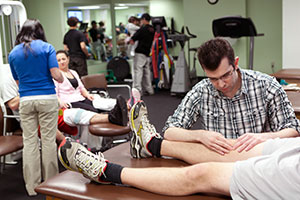- Locations
- Find a Physician
- By Physician
- By Department
- The Center for Spine Health
- Hand & Wrist Center
- Shoulder & Elbow Center
- Foot & Ankle Center
- Joint Replacement Center
- The Sports Medicine Center
- Pediatric Orthopedic Center
- Trauma & Fracture Center
- Osteoporosis and Bone Health
- Oncology Center
- Cartilage Repair Center
- Concussion Rehab Center
- OrthoDirect
- Careers
- Patient Portal
- Intranet
 Partial knee replacemet or total knee replacement?
Partial knee replacemet or total knee replacement?
The knee joint relates to three areas of the knee: 1. the inside part of the knee; 2. the outside part of the knee; and 3. the front of the knee under the femur (thighbone).
 If the damage to the knee, and the arthritis is confined to just one part of the knee, the joint replacement surgeon may recommend a partial knee replacement for the purpose of sparing the most bone as possible during surgery.
If the damage to the knee, and the arthritis is confined to just one part of the knee, the joint replacement surgeon may recommend a partial knee replacement for the purpose of sparing the most bone as possible during surgery.
In fact, bone sparing is the main objective of all modern knee and hip replacement surgery. The more natural bone that can be preserved during joint replacement, the better.
Sadly, many orthopedic surgeons note that too many patients receive total knee joint replacements when they only needed partial knee joint replacement. This typically is because the patient went to a joint surgeon that is not as well trained or experienced in the most advanced joint replacement techniques, and that includes the most current robotic surgery technology.
Consequently, the burden is on the patient to research the best-trained and most experienced joint replacement surgeon to assess their joint pain issue, as that will determine if they receive the optimal clinical outcome with the most bone preserved during joint replacement surgery.
Knee replacement with an artificial joint
Osteoarthritis is the most common reason for replacing an arthritic knee with an artificial knee joint.
Knee replacement surgery was first performed in 1968. Over the past 50 years, the procedure has greatly improved the lives of patients, enabling patients to walk and plays sports again without the limitation of pain symptoms.
Each year, there are more than 200,000 total knee replacement surgeries in the United States. About 65 percent of total knee replacements are done on women, with an average age of 68 years old. About 25 percent of all knee replacements are done on middle-aged men and women between forty-five and sixty-four years old.
Total knee replacements are one of the most successful procedures in all of medicine. It’s estimated the almost 800,000 knee replacements are performed each year in the United States. It’s estimated that about 4.5 million Americans are currently living with at least one total knee replacement. About 63% of the patients who receive a total knee replacement are women.
Over 10 years to 2009, total knee replacement increased by 84% in the American population. Ironically, it’s not the elderly driving the large increase in knee replacement surgery. The increase is coming from younger and middle-age Americans that have lost control of their weight, and their obesity has destroyed their knees.
According to the U.S. Government’s National Center for Health Statistics, women had a higher rate of total knee replacement than men. In 2010, total knee replacement was the most frequently performed inpatient procedure on adults 45 and older. The mean age for having a total knee replacement was is getting younger, from 68.9 years old in 2000 to 66.2 in 2010.
Who is a candidate for an artificial knee joint?
Total knee replacement is reserved for the patient who has not benefited from conservative treatments and whose quality of life is suffering due to the debilitation caused by knee pain. Examples include those experiencing pain at night and those who cannot perform their normal, everyday activities.
Typically knee replacement is reserved for those who are over 60 years of age who are in relatively good health. That’s because the lifespan of an artificial joint is estimated to last 15 to 20 years. The goal is to have the artificial joint outlive the person.
Many times that is simply not possible because more people can benefit from joint replacement while in their 40s and 50s. This ultimately can require a complex revision surgery when the person is in their 60s or 70s when other health issues may be a complicating factor to a second surgery and a longer recovery.
Active knee replacement candidates will find it comforting to know that they will be able to resume some athletics following surgery such as golf, swimming, and walking. Some knee replacement recipients have even continued to play tennis and snow ski. Unfortunately, a knee prosthesis is not quite as effective as a healthy, natural knee, however it will be a great improvement over the preoperative pain and discomfort.
Who is not a candidate for artificial knee surgery?
As mentioned before, to receive knee replacement surgery, you must be a good candidate. If not, surgery could prove counterproductive.
For some, knee replacement surgery is not in their best interest. Those who are too young (except for those who suffer from severe rheumatoid arthritis) should consider other types of treatment for knee pain, since after 15 or 20 years, the prosthesis will need to be replaced.
Unfortunately, the bone will need to be cut short to make room for a new prosthesis, and function and mobility is likely to be damaged during the second operation.
Those who are overweight are not good candidates, as the prosthesis (just as the natural knee) is designed to carry a weight in proportion to the person’s body. Too much weight on the prosthesis can cause it to be damaged, and subsequent knee surgeries will be necessary. Those with cardiovascular problems and terminal illnesses are also not good candidates, as the surgery may be too much for the body to handle. Also, those with poor skin coverage over the knee are not good candidates, as surgery could impair movement of the knee.
How is artificial knee replacement performed?
During knee replacement surgery, you will be under general anesthesia meaning you will be asleep and without pain during the entire procedure, which usually lasts a few hours.
The knee is opened up and the kneecap is moved out of the way. Doctors then, shave off the bottom of the femur and the top of the tibia and fibula bones. The prosthesis is then glued to the bones with special, surgical cement. The knee is then sutured back together and drainage tubes are used to prevent clogging.
Usually, a hospital stay for knee replacement surgery lasts between four and five days. During your time at the hospital, your leg will be attached to a device called Continual Passive Movement (CPM), which will move your knee to prevent stiffness. After the hospital stay, the patient will probably require the aid of a walker for a few days before putting full weight on the leg. Overall, full recovery can take anywhere from two months to one year although dramatic improvements should be seen sooner than that.
Advanced joint replacement techniques
That goal of bone preservation in joint replacement has lead to the invention of new robotic technology that uses the power of the computer to map out a knee or hip joint in advance of joint replacement surgery to determine the minimal amount of bone that needs to be removed to install the artificial knee or hip joint.
With traditional knee replacement the joint surgeon uses simple X-ray images to assess the knee joint and plan their joint replacement surgery. Conversely, the modern joint surgeon trained in robotic knee or hip joint replacement uses a CT scan and robotic technology to build a computer model of the knee or hip and then create a surgical map that is used during joint replacement surgery. Using the robotic technology, the computer enables the joint surgeon to use a programmed robotic arm in resurfacing the damaged part of the knee. The robotic arm enables the joint surgeon to make more precise bone cuts to achieve the best installation of the artificial joint.
The Mako Robot is the most commonly used joint replacement robotic technology currently. The advanced technology is not cheap. Hospitals typically pay $1 million for the Mako Robotic Technology to perform robotic joint replacement.
The Mako Robotic System enables the joint replacement surgeon to do partial knee replacements more accurately than conventional partial knee replacements. Mako hip replacements can also be more accurate and reproducible than conventional hip replacements. The ultimate goal of the robotic surgery is to provide more precision in removing the arthritic bone while sparing and keeping as much healthy bone as possible.
According to Stryker, which manufactures the Mako Robotic System, a study of 150 total knee replacement patients who had computer-navigated total knee replacement had significantly less post surgical pain, and needed less pain medicine along with a shorter hospital stay.
The new robotic technology for joint replacement comes at an ideal time. With the aging baby boomers hitting their 60s and 70s, experts anticipate a 673% increase in knee replacements and a 174% increase in hip replacements over the next 10 years.








